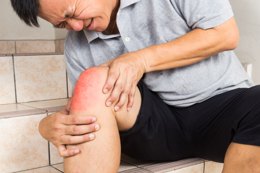Baker's cyst, hamstring injuries, popliteus injuries, etc., are some of the many factors that can lead to posterior knee pain. To get some more information on the causes along with available treatment measures, read on.

Pain in the knee is quite common and is suffered by almost 45% of the human population at any stage of their lives. The chances of experiencing it relatively increases as you enter middle age. It is more common in the anterior part. Pain in the aft part is a bit uncommon and affects only a small number of patients.
Causes
Out of numerous causes, the most common is injured soft tissues. Physical trauma to hamstring muscles, tendon of the gastrocnemius, or popliteus muscle results in mild to severe ache in the back area of the knee. Other examples of soft tissues whose injury can lead to such distress are ligaments in the area of the meniscus. Secondly, entrapped blood vessels can result in this. It particularly occurs when the popliteal artery gets entrapped.
Cancerous or non-cancerous growth of tissues located at the back of the knee often causes it to ache when walking. Entrapment of nerves can also result in pain. The nerves that are commonly found entrapped after sitting or while walking are the peroneal nerve and tibial nerve. Other common causes are osteoarthritis, formation of abnormal scar tissue post surgery, etc.
Treatment
Using a Compress: The treatment begins with taking rest and restricting your legs from getting strained physically. During this period, it is very important for you to apply a hot or cold compress on the aching knee. The choice of hot or cold compress depends upon your suitability and comfort. The use of a compress will reduce swelling, pain, and prevent accumulation of fluid in the tissues.
Medication: You may take non-prescription, non-steroidal, anti-inflammatory drugs. This will relieve you from the pain and other discomfort. If after following these home remedies, you notice no or negligible improvement, it's time for you to see an orthopedic.
Professional Treatment: The orthopedic can prescribe analgesics to you. The prescription actually depends upon the intensity of the pain. In case you are obese or overweight, your orthopedic may ask you to lose weight, and come to a weight that is ideal according to your height, sex, and age. This is necessary as obesity puts extra strain on the knee, and thus aggravates the condition. The ideal way to lose weight is to follow a balanced diet and a moderate exercise regimen. Exercising moderately on a regular basis will also benefit you by reducing pain caused by injury.
Many a time, orthopedics make a patient wear leg braces. This speeds up the process of recovery by keeping the knee joint in a somewhat steady state. In some severe cases, the patients are even asked to use crutches while walking. Crutches provide support to the affected knee, and thereby give it an ideal condition for fast healing. If braces or crutches are recommended to you, then you should use them ideally, and strictly follow all the instructions given by your orthopedic. When all these treatment measures fail to deliver the desired results, the orthopedic can consider surgery as an option for cure.
Apart from the medical treatments given by your orthopedic, you should try to improve the healing capacity of your body. This will ensure a fast recovery. The best that you can do to strengthen your body's natural ability to restore itself to the normal state is to follow a healthy diet. The diet should be rich in proteins, vitamins, and minerals.
Disclaimer: This Buzzle article is for informative purposes only, and should not be used as a replacement for expert medical advice.


 Pain in the knee is quite common and is suffered by almost 45% of the human population at any stage of their lives. The chances of experiencing it relatively increases as you enter middle age. It is more common in the anterior part. Pain in the aft part is a bit uncommon and affects only a small number of patients.
Pain in the knee is quite common and is suffered by almost 45% of the human population at any stage of their lives. The chances of experiencing it relatively increases as you enter middle age. It is more common in the anterior part. Pain in the aft part is a bit uncommon and affects only a small number of patients.